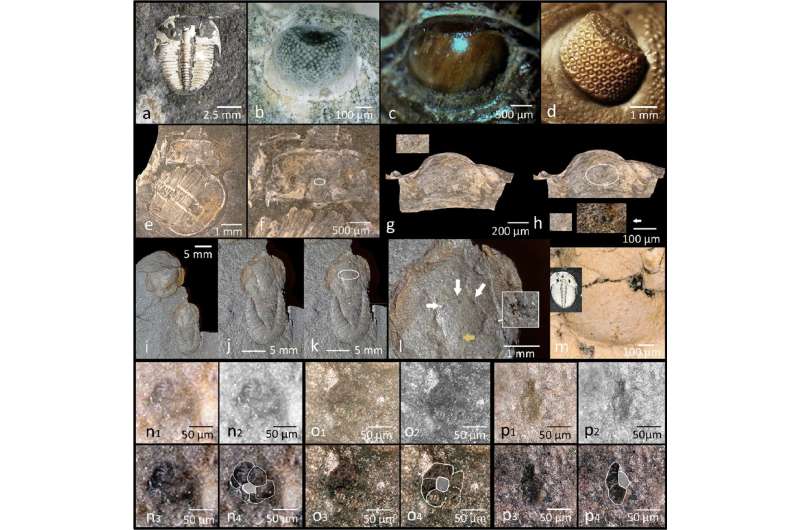New eyes discovered in trilobites

Trilobites, prehistoric sea creatures, had so-called median eyes, single eyes on their foreheads, in addition to their compound eyes, research conducted by Dr. Brigitte Schoenemann at the University of Cologne's Institute of Zoology and Professor Dr. Euan Clarkson at the University of Edinburgh has now found out.
Such single eyes are found in all arthropods and also in many relatives of the extinct trilobites. They are usually small cup eyes (ocelli), sometimes even equipped with lenses, and not unlike human eyes. These so-called median eyes are typical for all arthropods, but had not yet been discovered in trilobites despite 150 years of research.
The scientists assume that these eyes were characteristic of the larval stage of the animals. The single eyes were located under a transparent layer of the carapace, which became opaque during the fossilization process. Both circumstances contributed to the ocelli not being discovered until now. The researchers also detected median eyes in other, approximately 500-million-year-old arthropods.
Depending on their evolutionary status, these arthropods had different numbers of median eyes. In future, the number and shape of the single eyes will help to classify the evolutionary status of individual arthropod species. The researchers have published their findings in Scientific Reports.
Arthropods usually have two types of eyes: compound eyes and the so-called 'median eyes' or middle eyes. The latter are located in the middle of the forehead between the compound eyes. Only trilobites, an important group of arthropods in the Paleozoic, did not seem to have had median eyes.
This was the assumption until Schoenemann and Clarkson examined a specimen of the trilobite Aulacopleura koninckii in which part of the head had been scraped off. They found three almost identically shaped dark, inconspicuous and tiny oval spots of the same size at the front of the head. These three structures are parallel to each other and fan out slightly on the underside. All three spots are characterized by a smooth, clear outline and a uniform, dark brownish color.
"This clear, regular appearance distinguishes this structure from random formations produced by decay or fossilization, and corresponds to the expected relics of simple median eyes equipped with a pigment layer. Even if it is a single find, it supports the assumption that trilobites originally had median eyes," Schoenemann explained.
In the trilobite Cyclopyge sibilla, which lived in the free ocean, the researchers also found three cup-shaped median eyes on the so-called glabella, the region in the middle of the forehead between the large compound eyes, which even apparently had a lens not unsimilar to human eyes, and were thus clearly more differentiated and probably much more efficient than those of the bottom-dwelling trilobite Aulacopleura.
In their article, the researchers also consider why the median eyes of trilobites have escaped detection until now: "These eyes are present in trilobites at the larval stage, but lie beneath what is probably a thin, transparent carapace (cuticle), which becomes opaque during fossilization. Both explain why they have remained undiscovered until now," she added.
Thus, the researchers have solved the mystery of missing middle eyes in trilobites. Schoenemann said, "These cup eyes are derived from those of the primitive stump-footed animals, so-called velvet worms, small worm-like animals with legs. The original number of median eyes is 2, which present-day, very conservative arachnids still have. In phylogenetic, very primitive arthropods (e.g. Cindarella eucalla from the lower Cambrian of China) there are 4, modern animals, such as insects and crustaceans, have only 3. With the help of the number of median eyes in an arthropod, we now have an important tool to determine its position in the evolutionary tree."
More information: Brigitte Schoenemann et al, The median eyes of trilobites, Scientific Reports (2023). DOI: 10.1038/s41598-023-31089-7
No comments:
Post a Comment